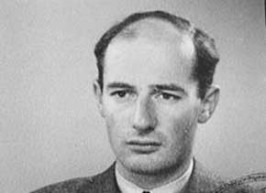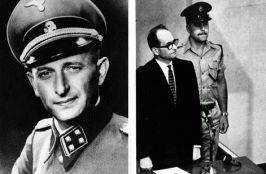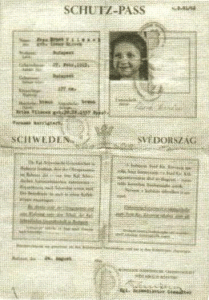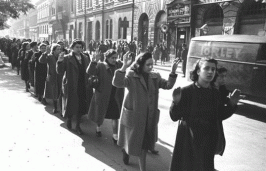The Raoul Wallenberg Unit of B’nai B’rith, together with the City of Port Phillip, has held the annual Raoul Wallenberg Commemoration marking the date on which he was arrested by the Russians in Budapest, Hungary.
Wallenberg was taken into captivity in Russia on 17 January 1945.
The Hon Michael Danby MP was Guest Speaker.
Other speakers included the Mayor of the City of Port Phillip, Amanda Stevens; Emeritus Professor Louis Waller AO; Raoul Wallenberg Unit co-president Margaret Heselev; and organiser of the function and MC Phil Symons.
The function, attended by around 100 people including the ministers and members from the Swedish Church in Melbourne and members of Parliament, was held at the St Kilda Town Hall.
Danby’s address:
Simon Dubnow, the Yiddish writer and historian, left us one plea from the Riga ghetto, before the German Nazis murdered him “Schreibt Und farshreibt”- “write and record”.
When in January 1945 a minor 32 year old Swedish diplomat was ‘disappeared’ by Russian troops occupying Budapest, few noticed. However, as time has passed, the name of that Swedish diplomat has become known the world over.
Raoul Wallenberg
Raoul Wallenberg has become a paradigm of the righteous. What might have been. What one man might do, faced with the ultimate in evil. And his hour was the last months of Nazi power in Europe; in Hungary. In Budapest where the last major Jewish community in Europe managed to preserve themselves until mid-1944. In Budapest where his antithesis, the paradigm of evil, Adolf Eichmann, wrought the last act of the ghastly bureaucrats meeting in Wannsee. Eichmann and his Nazis who struggled to implement to their last breath and even though the war was lost, Hitler’s pledge made to the Reichstag in January 1939 that the world war would end with the “Vernichtung der jüdische rasse in Europa”
Wallenberg and Eichmann. Light & Dark. Good & Evil. Emissaries of God and the Devil.
Last year Prime Minister Julia Gillard made Raoul Wallenberg Australia’s first honorary citizen, after a campaign by Professor Frank Vajda & B’nai B’rith and others for official Australian government recognition of his deeds. He is also an honorary citizen of the United States, Canada, Hungary, and Israel.
Now I could have given you some saccharine comments, so beloved of the easy anti-historical zeitgeist of our times, especially here in faraway, happy, easy-going rich Australia.
Given Dubnow’s cry, from beyond the grave however I decided to make what the Germans call a serious speech, something befitting Raoul Wallenberg.
My remarks are almost entirely based on the writings of one of the most popular historians of our day, Antony Beevor, from whom much of this research is wrought.
These were the circumstances under which this monumental struggle between Eichmann and Wallenberg took place.
Hungary, allied to Germany, was not occupied until March 1944. The Hungarian leader Admiral Horthy tried to take his country out of the War in October as the Red Army approached.
“On the morning of 15 October, just before Miklos Horthy’s announcement of the armistice, Skorzeny’s SS commandos managed to kidnap Horthy’s son in a street ambush after a shoot-out with his bodyguards. Horthy was trussed up, flown to Vienna and transferred to Mauthausen concentration camp, which already contained such Prominenten as Francisco Largo Caballero, the former prime minister of the Spanish Republic. Horthy was told bluntly that, if he persisted with his ‘treason’, his son would be executed. The admiral, although in a state of nervous collapse at the threat, went ahead with his broadcast. Arrow Cross storm troopers seized the building immediately afterwards and put out a denial, insisting on Hungary’s determination to fight on.”
Hungary had a small particularly repulsive uber-Nazi party, the Arrow Cross, led by Ference Szalasi.
“Ferenc Szalasi took power later (the) afternoon (of the attempt) to withdraw Hungary from the Axis. Horthy was brought back to Germany in protective custody.
Beevor explains:
“Horthy had put a stop to Eichmann’s deportation of Jews in the summer, by which time 437,402 had been killed, mostly at Auschwitz. But even though Himmler was halting the mass extermination programme with the approach of the Red Army, the remaining Jews were rounded up for slave labour and forced to march to Germany because of a lack of rolling stock.
“Tormented, beaten and clubbed to death by SS and Arrow Cross guards, many thousands died on the way. Although Szalasi stopped these death marches in November, more than 60,000 Jews remained prisoners in a tiny ghetto in Budapest. Most of Arrow Cross’ followers were now determined to embark on their own ‘Final Solution to the Jewish question’.”
Arrow Cross militia, some of them aged from fourteen to sixteen years old would seize groups of Jews from the ghetto, force them to strip to their underclothes and march them barefoot through the freezing streets to the Danube embankments of the city for execution. In many cases, their firing was so inaccurate that a number of victims managed to jump into the icy river and swim away.”
“The greatest operation to save Jews was mounted by the Swede Raoul Wallenberg who, despite having no more than semi-official status in Hungary, issued tens of thousands of documents stating that the bearer was under the protection of the Swedish government. Later, during the siege, the Arrow Cross invaded the Swedish embassy and murdered several of its staff in revenge for their activities. Along with the Swedes, the Swiss diplomat Carl Lutz, the Portuguese diplomat Carlos Branquinho, the International Red Cross and the papal nuncio issued their own protection papers to help other Hungarian Jews escape.”
Wallenberg was not the only person struggling to save Jews from the Nazis and Arrow Cross. According to Beevor:
“The most extraordinary bluff emerged from the Spanish embassy. The Spanish charge d’affaires, Angel Sanz-Briz, knew that the Szalasi regime was desperate to be recognized by his government. He encouraged its members in this illusion, while taking on the Arrow Cross even more robustly than the Swedish embassy. Sanz-Briz was forced to leave, but he handed over to a new ‘charge d’affaires’, Giorgio Perlasca, who was in fact an Italian anti-Fascist. Perlasca assembled 5,000 Jews in safe houses under Spanish protection, while Franco’s government in Madrid had no idea of what was being done in its name.
Wallenberg operated in a context where even as Budapest was surrounded, by the Red Army on 26th of December, Hitler sent 2 fearsome SS Panzer formations to assist the already formidable Nazi formations still gripping the city.
Beevor continues and I’m sorry to have remind people of the extreme violence of the Nazi’s and Arrow Cross but it does make what Wallenberg did all the more remarkable.
“Although many of the Arrow Cross had fled the city before the encirclement, 2,000 of their fanatical paramilitaries remained. These volunteers appeared to spend more time killing the Jews still in the city than fighting the enemy. Surprisingly, SS Obergruppenführer Pfeffer-Wildenbruch forbade German soldiers from participating in the killings, although other senior German officials welcomed the fact that Hungarians were taking on the task with brutal enthusiasm. An increasing number of starving Jews resorted to suicide. In the first week of January 1945, the Arrow Cross seized a number of Jews under Swedish protection on the grounds that, since the government in Stockholm did not recognise the Szalasi regime, they did not accept the documents issued in its name. The Arrow Cross rounded up these Jews, beat them senseless and later took them in groups to the Danube Embankment for execution. On 14 January, Father Kun took a band of Arrow Cross to the Jewish hospital in Buda. They slaughtered patients, nurses and everyone else they found there, a total of 170 people.
On hearing of an Arrow Cross plan to attack the ghetto in Pest, Raoul Wallenberg sent a message to the German commander (General Schmidhuber), that he would be held responsible if he did not prevent the massacre. Schmidhuber sent Wermacht tripps into the ghetto forestall the Arrow Cross. A few days later, the ghetto was overrun by the Red Army.
So Raoul Wallenberg’s documents preserved tens of thousands of Jews in the terrible months of ’44, when Hungary was under Nazi occupation. He then prevented the liquidation of the Ghetto at the moment of its greatest peril, with his bluff of using the Wehrmacht to prevent an Arrow Cross massacre of the surviving defenseless Jews.
What happened after the liquidation of Budapest from the Nazis?
In the aftermath of the battle, Red Army soldiers shot German wounded – some were dragged out and crushed under tanks – including members of the SS and auxiliaries.
Anyone in German uniform who did not reply in German was also likely to be killed. Few Hungarian combatants were shot. Almost all the men, even Communists who had fought with the resistance against the Arrow Cross, were rounded up for forced labour. Prince Pal Esterhazy was put to work burying dead horses in Pest.”
In those circumstances and after the most brutal war on the Eastern front where 20 million Russians died, the Russian Army showed no mercy or subtly.
Now Beevor’s most interesting remark about Wallenberg.:
“The NKVD and SMERSh displayed full Stalinist paranoia, suspecting anyone with foreign contacts of being a spy, including Zionists. Raoul Wallenberg was arrested on 19 January along with the forensic pathologist Ferenc Orsos, who had been one of the international observers with the Germans when they dug up the Polish corpses in Katyn forest. It is assumed that Wallenberg had also seen the Katyn report, and that he was suspected of having close contacts with the British, American and other intelligence services. Beeevor’s analysis is that Wallenberg was arrested by SMERSh, and executed in July 1947.”
According to a detailed chronology composed by the Raoul Wallenberg Committee of the United States, the first Soviet account of Wallenberg’s whereabouts reportedly occurred on 18 August 1947, where the Soviet Foreign Minister informed the Swedish government that “Wallenberg is not in the Soviet Union and is unknown to us”.
Later on 2 February 1957—according to the same chronology— the Soviet Deputy Foreign Minister Gromyko passed the Swedish government a handwritten report indicating that Wallenberg had died on 17 July 1947 of a probable heart attack, with his body cremated without autopsy. However, later accounts provided by Soviet officials reportedly indicated that Wallenberg was likely executed while in prison.
In terms of notable people involved in the arrest and detention of Wallenberg, the eventual Soviet leader Leonid Brezhnev may have been directly implicated in Wallenberg’s arrest, having been head of the political squad of the Russian Army’s 18th division, located in Budapest at the time of Wallenberg’s arrest. Various accounts of Brezhnev’s involvement are detailed in Alan Gersten’s A Conspiracy of indifference: the Raoul Wallenberg story, Harvey Rosenfeld’s Raoul Wallenberg: The Mystery Lives On and Dmitri Stonov’s In the past night: the Siberian stories. Additionally, a separate account on the International Raoul Wallenberg Foundation website suggests that Wallenberg’s arrest may also have come directly from the Soviet leader Stalin, by way of the Soviet Deputy Minister for Defence.
Another Soviet leader, Nikita Kruschev, was the Political Commissar attached to the Soviet army which captured Budapest and Lake Balaton and would also be implicated.
Michael Danby with B’nai B’rith’s Raoul Wallenberg unit’s co-President, Margaret Heselev, Phil Symonds, Mayor Amanda Stephens and Emeritus Professor Louis Waller in the city of Pt Phillip Council Chambers
Prime Minister Julia Gillard at the Citizenship Ceremony last year to award Raoul Wallenberg the first ever honorary citizenship to be awarded by Australia said, “Some of the individuals whose lives he redeemed became part of our first, great transforming wave of post-war immigration; among the first to pledge themselves to their new home after Australian nationality was formalised in 1949. Now, seven decades later, Raoul Wallenberg will join them as an honorary Australian citizen. This will be the first time this honour has been bestowed by our country. And I cannot imagine a more fitting individual upon whom to bestow it.”
She thanked the Governor-General for this magnificent act of state to enshrine this most righteous of human beings in our national family forever.
Governor-General Quentin Bryce at the Citizenship Ceremony quoted Nobel Laureate, writer and Holocaust survivor, Elie Wiesel who said:
“The opposite of love is not hate,
it’s indifference.
The opposite of art is not ugliness,
it’s indifference.
The opposite of faith is not heresy,
it’s indifference.
And the opposite of life is not death,
it’s indifference.”




